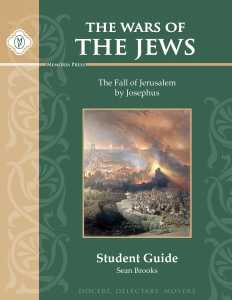The works of Flavius Josephus are considered valuable because of their coverage of Jewish history, but especially for Josephus’ contemporaneous reporting of Jewish events during the first century. The entire works of Josephus are too lengthy for most high school students to read, so this study has selected only those parts that center around the fall of Jerusalem to the Romans, titling the course The War of the Jews. The War of the Jews doesn’t cover references to Jesus, John the Baptist, and John the Apostle that are found elsewhere in Josephus’s works. Instead, it is primarily a history of the conflict between the Romans and the Jews. It goes into extensive detail about the key people and events, including the politics of the situation. The subject matter is likely to be of interest to Christians and others seeking to understand Jewish history as well as to those studying the Roman Empire.
There are three components to this Memoria Press course. The Wars of the Jews, the abridged book from the works of Josephus, includes chapters 6 through 13 of Book V and chapters 1 through 10 of Book VI. Endnotes and a few black-and-white illustrations are included.
The student guide divides the reading material in The Wars of the Jews into ten lessons, with two pages per lesson in the student guide. Each lesson includes “Facts to Know”—key people, places, events, and specialized terms students need to know to understand the reading material. There are two vocabulary words to define in the first lesson, but none in the other lessons. The bulk of each lesson consists of comprehension questions related to the assigned reading. A three-page final review at the end of the student book serves as a test for the course.
The teacher key is strictly an answer key.
The Wars of the Jews is very straightforward and easy to use. High school students should be able to read through it independently and answer questions on their own. Parents or teachers need only check that answers are correct. The course should take no more than eleven weeks if you stretch it out using only one lesson per week and the test, but it can easily be completed in about half that time. That makes it appropriate for use as a supplement to a broader study of ancient history. But for students in at least tenth grade, it also works in conjunction with two other courses from Memoria Press, On Obligations and The Republic and the Laws, both based on the works of Cicero.








